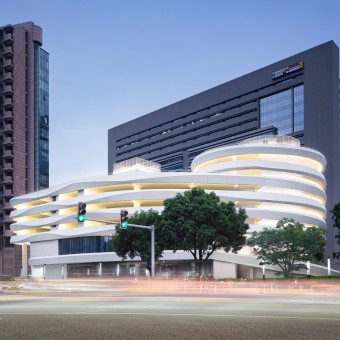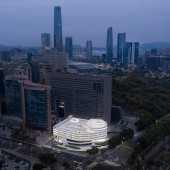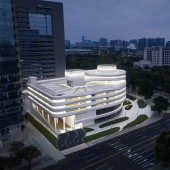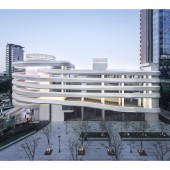Dongguan Garage Building Garage by Guowei Zhang |
Home > Winners > #126102 |
 |
|
||||
| DESIGN DETAILS | |||||
| DESIGN NAME: Dongguan Garage Building PRIMARY FUNCTION: Garage INSPIRATION: Using the infinitely flowing loops to organize the traffic circulation, two independent yet equally dynamic curves spiral up and intertwine, forming an architectural image as an urban sculpture. UNIQUE PROPERTIES / PROJECT DESCRIPTION: The inspiration of this project combines both the unique meandering water-bodies of Dongguan and the unique core location of the site, proposing to extend the two major streets as flowing, water-like ribbons, in order to reform the chaotic existing parking conditions in the vicinity and establish the spatial and facade languages for the new garage building. OPERATION / FLOW / INTERACTION: The design uses the traffic circulation unique to garage as a tractive force to create the volume through the continuously looping of the building, and then refine the volume according to the site’s geometry until a pure architectural form is eventually achieved. The continuously looping ribbon on the facade circles around the building volume and reaches each corner, generating a series of rich and diverse spatial forms, which visually create a set of architectural language from inside to outside, whose moods are fused in harmony with the urban context. PROJECT DURATION AND LOCATION: The project started in 2019 in DongGuan, China, and under Construction,will be completed in 2022 FITS BEST INTO CATEGORY: Architecture, Building and Structure Design |
PRODUCTION / REALIZATION TECHNOLOGY: The design team continues to learn from the flexibility of flowing water. Through a linear design language that is both dynamic and lithesome, the continuous white ribbon with local turns and loops waves and fluctuates, spiraling upwards, forming the everchanging beauty of the facade. The GRC as the material for the white ribbons not only reflects the unique textures of the flowing curves, but also merges with the vast land as one. SPECIFICATIONS / TECHNICAL PROPERTIES: Design team has gone through multiple rounds of discussion and demonstration with the owner regarding the functions of the project and has designated retail spaces from B1 to P2 and on the rooftop. On B1 through P2 there are clustered retail spaces, whose spatial layout can be either divided or combined according to actual needs, to hold larger businesses. Design team sets a floating pedestrian bridge through north and south of the Ground Floor, connecting the central retail square and the city park on the south. TAGS: Tags,a landmark parking garage, Tags,GRC material RESEARCH ABSTRACT: Located on a site of 4,844 m2 area, the Garage Building in Dongguan has a gross floor area of 20,575 m2. It is the very first pilot project of Dongguan to renew the city’s image and relieve the pressure on its traffic network. The project is at the intersection of Shizhu Road and Tiyu Road, Guangcheng District, which is part of the “One Center & Two Axis” urban core of Dongguan. Within the 200-meter radius from the City Hall, the site is surrounded by the greenery in the vicinity where a collection of urban functions including municipal administration, offices, retails, and hotels is also clustered as a crucial demonstration of the city’s culture and spirit. This area has long been troubled by multiple risks in traffic such as lack of designated parking space and encroachment of streets. Starting from the project’s actual requirements in function while merging the innovative design concepts into the comprehensive image of a new urban landmark, GWP strives to resolve the local traffic issue and improve the experience on the road for urban commuters, as well as to create a new urban ‘place’ for people to gather and stay. CHALLENGE: Design team uses a highly expressive and space-saving spiral ramp structure on the southwestern part of the building, which can direct vehicles from level one through six quickly and efficiently, therefore greatly improve the parking efficiency. Meanwhile, the spiral ramp connects with the façade seamlessly, enabling high level of consistency and continuity in the exterior of the building. The garage uses a sloping floor parking design, with an inclined spiral ramp at the center, circling and reaching all interior spaces. The driving lane on the ramp is for through traffic, while the parking areas are along both edges of the ramp. The sloping floor design is estimated to be 30% more efficient in the use of space, and can provide 25% more usable parking spots, which ingeniously resolves the problem of lack of parking space in the vicinity of the project. Pedestrian and vehicle circulations are separated on the plan. Individual circulation networks are designed for each type of vehicles, mainly commercial vehicles, private vehicles, and mini-buses, which enables flexible responses to emergencies in the garage. An atrium is established at the center of the infinitely flowing circulations, which greatly enriches the visual experience for people in the building after parking their vehicles and improves the natural ventilation inside the garage. Exhaust brought by the vehicles can be pulled out through the atrium to the exterior, while fresh air can flow into the garage through the gaps between ribbons on the façade, creating a positive cycling of air. ADDED DATE: 2021-05-08 09:55:34 TEAM MEMBERS (1) : John Zhang IMAGE CREDITS: GWP Architects |
||||
| Visit the following page to learn more: https://www.gwp-architects.com/project/p |
|||||
| AWARD DETAILS | |
 |
Dongguan Garage Building Garage by Guowei Zhang is Winner in Architecture, Building and Structure Design Category, 2021 - 2022.· Read the interview with designer Guowei Zhang for design Dongguan Garage Building here.· Press Members: Login or Register to request an exclusive interview with Guowei Zhang. · Click here to register inorder to view the profile and other works by Guowei Zhang. |
| SOCIAL |
| + Add to Likes / Favorites | Send to My Email | Comment | Testimonials | View Press-Release | Press Kit |
Did you like Guowei Zhang's Architecture Design?
You will most likely enjoy other award winning architecture design as well.
Click here to view more Award Winning Architecture Design.








